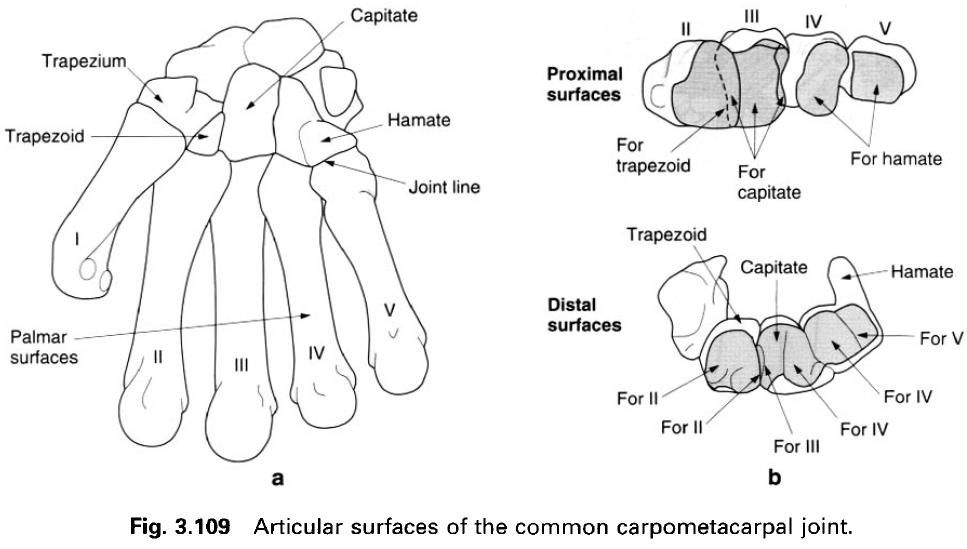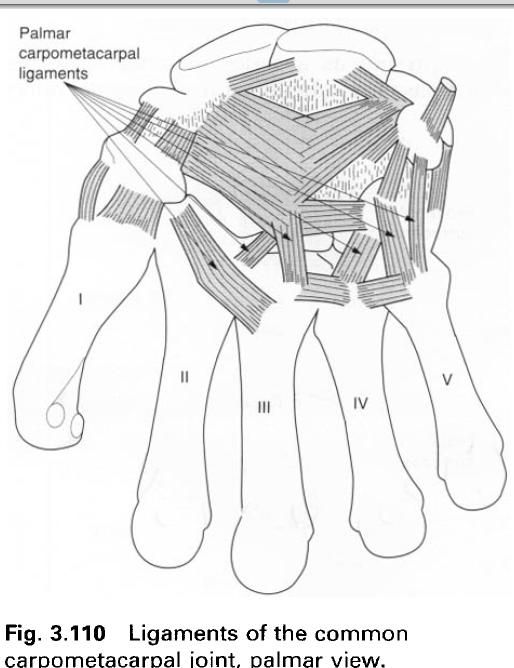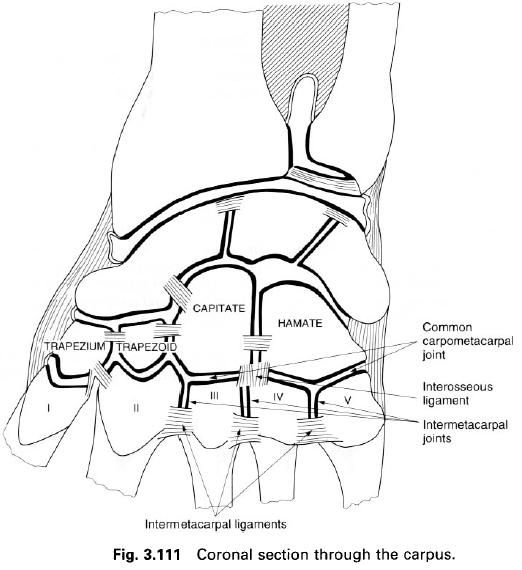The carpometacarpal joints are the sites of
articulation between the carpal and metacarpal bones. The bases of the medial
four metacarpals form, with the distal row of carpal bones, a common
carpometacarpal joint, which has an irregular joint line. The joints are, on
the whole, plane synovial joints, the only exception being the slightly beveled
joint surfaces between the hamate and the base of the fifth metacarpal.
Articular surfaces
The base of the second metacarpal fits into a
recess formed by the medial side of the trapezium, the distal surface of the
trapezoid and the anterolateral corner of the capitate. The third metacarpal
base articulates only with the distal surface of the capitate. The base of the
fourth metacarpal articulates mainly with the anterolateral distal surface of
the hamate, but also just catches the anteromedial corner of the capitate.
Finally, the base of the fifth metacarpal abuts against the anteromedial part
of the distal surface of the hamate.
Joint capsule and synovial membrane
A fibrous capsule surrounds the common joint,
in which various capsular thickenings can be identified. Synovial membrane
lines the capsule and all non-articular surfaces, attaching to the articular
margins. The joint cavity extends proximally between the carpal bones, and
usually communicates with the midcarpal joint. Distally the joint space extends
between the bones of the medial four metacarpals.
Ligaments
The dorsal and palmar carpometacarpal ligaments
are really just thickenings of the joint capsule.
Dorsal
carpometacarpal ligaments
These present as a series of bands of fibres
which pass from the distal row of carpal bones to the bases of the metacarpals.
In general, each metacarpal receives two bands. Those to the second metacarpal
come from the trapezium and trapezoid; those to the third from the trapezoid
and capitate, and those to the fourth from the capitate and hamate. The base of
the fifth metacarpal receives only a single band arising from the hamate.
Palmar
carpometacarpal ligaments
The arrangement of the fibrous bands
constituting the palmar carpometacarpal ligaments is similar to those for the
dorsal ligaments, except that the base of the third metacarpal receives three
bands arising from the trapezoid, capitate and hamate.
Interosseus
ligament
A short interosseus ligament is usually present
passing from the adjacent inferior angles of the capitate and hamate to the
base of the third or fourth metacarpal or both. Occasionally, the ligament
divides the joint space into medial and lateral compartments.
Blood and nerve supply
The arterial supply to the joint is from the
palmar and dorsal carpal networks, while the nerve supply is by twigs from the
anterior and posterior interosseus nerves and the deep and dorsal branches of
the ulnar nerve.
Relations
The carpometacarpal joints of the fingers lie
deep to the tendons of flexor digitorumsuperficialis and profundus. Most laterally on the palmar surface, the
tendon of flexor carpi radialis
crosses the joint to insert into the base of the second metacarpal, while the
tendon of flexor carpi ulnaris passes
most medially. Also overlying the joint medially are the muscles of the
hypothenar eminence.
On the posterior aspect of the joint are the
tendons of the extensor muscles as they pass into the hand. From the lateral to medial these are: extensor carpi radialis longus at brevis, extensor pollicis longus,extensor indicis, extensor digitorum and digiti minimi, and extensor carpi ulnaris.
Stability
The joint is extremely stable, providing a firm
base between the joints of the wrist and the hand.
Movements
There is little movement at the carpometacarpal
joints of the fingers. The second and third metacarpals are essentially
immobile, while a slight amount of gliding may occur between the fourth
metacarpal and the hamate. Only the fifth metacarpal shows any appreciable
movements as it glides on the hamate, and this is because of the beveled joint
surfaces. The movement that occurs is flexion, and is seen during a tight grasp
and in opposition of the thumb to the little finger. In addition, there is also
a slight rotation during opposition due to the action of opponens digiti minimi.
Accessory
movements
A slight degree of anteroposterior gliding can
be produced between the base of the metacarpal and the adjacent carpal bone if
the appropriate pressure is applied.












0 коментара:
Постави коментар